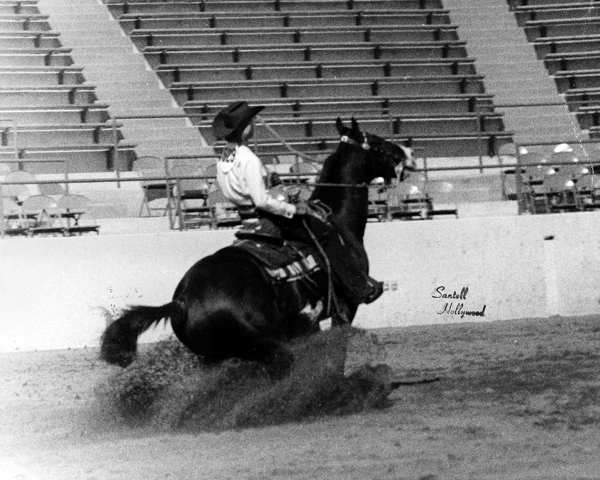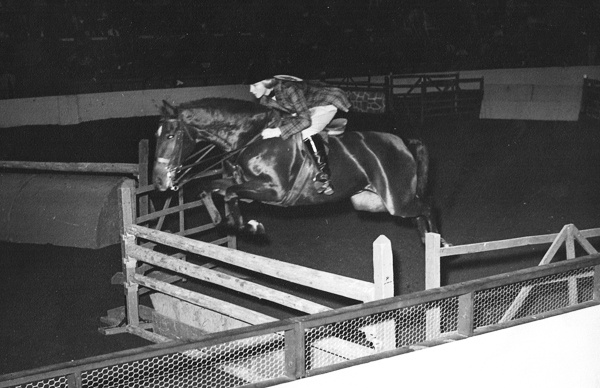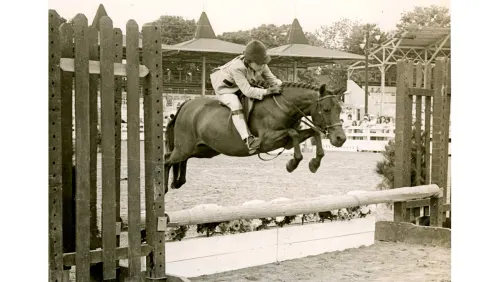It’s hard to imagine today’s hunter seat equitation riders having time to pursue other riding endeavors as they prepare all year to qualify and compete at their major finals, but in the 1960s, it wasn’t uncommon for a junior rider to compete in more than one discipline.
During that time, Lindy Patrick was nearly unbeatable in the hunter seat, saddle seat and western stock seat medal classes on so many horses, she can’t even remember them all. In those days, some shows hosted several disciplines, which made her life even more hectic.
“At the shows, it could be a real circus, where I’d do one event and them have to change clothes and jump on and ride another horse in another event,” she said. “It kept me from getting nervous! In my head, I never had a problem with [riding in different disciplines]—it was just so natural for me. I had no issues switching from seat to seat. You’re still riding a horse!”
Patrick, now in her mid-60s, grew up in Pasadena, Calif. When she begged for riding lessons at age 7, her mother insisted she get a well-rounded equestrian education, so she started training with Elsie Gustafson, a master of many types of riding.
Patrick soon decided it was time to start working with discipline-specific trainers, so she joined the Flintridge Riding Club and trained with Jimmy and Marcia “Mousie” Williams for hunters and jumpers.
She also trained with Harold Farren for stock seat and Helen Crabtree for saddle seat.
Patrick noted that some of her peers and those that came before her split their time between disciplines, including Luann Beach, who rode in hunt seat and saddle seat (she won the AHSA Stock Seat Medal Finals in 1954 and the Saddle Seat Medal Finals in 1956) and Barbara Worth, who rode hunt seat and stock seat.
The U.S. Equestrian Federation, formerly the American Horse Shows Association, started the equitation medal program in 1937. For the first 10 years, the finals included stock seat, saddle seat and hunt seat competing together at the same show, but in 1948, the Stock Seat Medal Final became a separate event and has been known as the USEF Reining Seat Medal Final since 1999. The USEF Saddle Seat Medal Final is also held separately these days, but was once held at the National Horse Show (N.Y.) at Madison Square Garden alongside hunter and jumper classes.
Patrick traveled east for several of her junior years to the fall indoor shows. In 1962, she focused only on the Saddle Seat Medal Finals, held at the National.
She didn’t have a suitable mount that spring, but a few months prior to the National, one of Crabtree’s students sold her top saddle seat equitation mount to Patrick.
ADVERTISEMENT
While Patrick couldn’t remember the Saddlebred mare’s name, she did remember that it was tough to form a partnership so fast.
“I had about a month or two to get with her and get consistent and then go to the Garden and win,” she said. “It was a challenge. Working with her, she was just a little different [to the aids] then I was used to. I was used to more ‘dressage’ on my saddle horses, whereas she was more of a ‘slap n’ go’ kind of girl. I had to kind of drop back a little to get consistent and get in sync with her.”

Lindy Patrick after her AHSA Saddle Seat Medal Finals win. Photo by Freudy
Patrick also won the AHSA Stock Seat Medal Finals in 1963. Farren found one of her top stock seat mounts during those years, Alate Diamond, at a Quarter Horse race track. “He was difficult,” she remembered. “He was a challenge. Harold found him and trained me to ride him and off we went.”

Lindy Patrick on Alate Diamond. Photo by Santoff Hollywood
Patrick started focusing more on hunters and jumpers after winning the Stock Seat and Saddle Seat Medal Finals.
In 1963, she traveled to the Washington International Horse Show (D.C.) and won the AHSA Combined Test Medal, a class that featured a dressage test and jumping round, on Williams’ warmblood mare, Golden Arrow.
In 1965, Patrick came second in the AHSA Hunter Seat Medal at the National and went on to earn much success in the junior, equitation and open divisions aboard catch rides and her favorite junior hunter mount, No Commotion, an off-the-track Thoroughbred mare that Williams found for her.

Lindy Patrick on No Commotion at the National Horse Show in Madison Square Garden in 1964. Photo by Freudy
“She was a terrific mare,” she said. “I’d win stakes classes—she was fabulous. She was a top working hunter and she was my most memorable horse. I just loved her, her balance and her lightness—she very seldom had a bar down. She was just beautiful-moving and beautiful-jumping and we were a team. She was just very consistent. She wasn’t the prettiest, that’s why she was a working hunter. She was a little slight, but very light, balanced and athletic. She could leave from anywhere and it was never a problem. She just kind of floated.”
ADVERTISEMENT
Patrick retired the mare to a field when she went off to college, but not until she retired the working hunter stake trophy at the Del Mar Horse Show (Calif.), which is now awarded each year as the No Commotion trophy.
By the end of her junior career, Patrick admitted she was a bit burned out as she prepared to head off to college.
“I was very fortunate that my parents supported me so fully and allowed me to ride with some of the best trainers and gave me some wonderful horses to ride,” she said. “A lot of it’s being lucky. I was busy. I think that’s why I quit—as much as I loved it and was just totally immersed, I think I was ready to move on and kind of be a normal teenager and go to college and see what other people do besides ride horses.”
After graduating from the SUNY State College of Forestry (N.Y.) with a degree in landscape architecture and environmental science, Patrick ended up in the title insurance industry before retiring five years ago in Parker, Colo., with her husband Geoff.
In the 1990s, she grew passionate about showing and breeding Australian Shepherd dogs and now devotes all of her time to it. “I’m very immersed in that,” she said. “It’s a throwback to the horse show days. I’m competitive and I enjoy the competition and the training and working with the dogs.”
While she rode a bit in the ‘70s, she hasn’t had an interest in picking it back up again. Occasionally she’ll head to the nearby Colorado Horse Park to watch a friend, like jumper Susie Hutchison, compete, and she keeps up with a few old friends on Facebook.
She admitted that specialized horse showing today is a lot different than it was back then.
“[Riding multiple disciplines] really is probably easier than people think,” she said. “It’s like music—it’s the same 12 notes. The aids really are the same. Your balance and all of that is really closer than people realize. The riders and horses today when I watch are beautiful. It’s come a long way since when I was doing it. You can see the balance and collection. It used to be that dressage was such a foreign thing, but now you see it everywhere—the same principles anyway.”
All photos courtesy of Lindy Patrick















